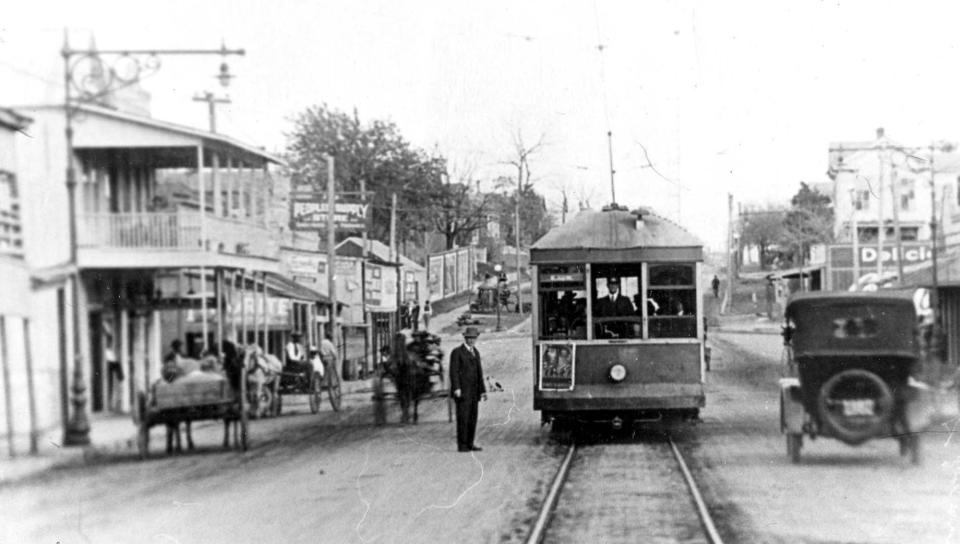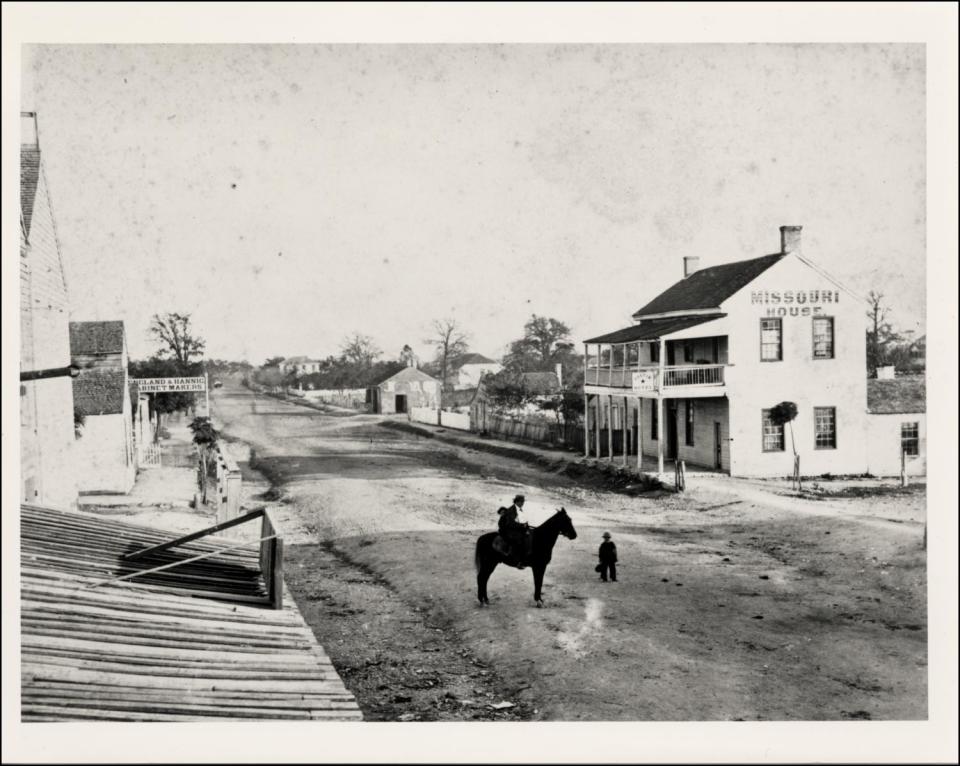Did you go there? Help us name a lost Austin bar on East Sixth Street
- Oops!Something went wrong.Please try again later.
Somebody should write a history of East Sixth Street.
To be fair, Allen Childs did produce the slender yet instructive volume, "Sixth Street," for Arcadia Publishing's Images of America series.
Crackling tales of Sixth Street turn up in books by Jesse Sublett, Michael Corcoran and Joe Nick Patoski, among others.
A comprehensive history, however, is waiting for an ambitious author. (Don't look at me. I'm busy finishing the fifth volume of the "Indelible Austin" series. Expect a box set by the end of the year.)
The subject of Sixth Street history came up again last week when reader Jess Airaudi asked Austin Answered about one of the many long-gone joints on the iconic way.
"I wondered if anything recent has come up about a place I had asked you about some time ago, a bar on Sixth Street near Congress run by two Lebanese brothers, 'Benny,' for one, which I think gave the bar its name, at least informally," Airaudi wrote. "The long bar in front was popular, but it seems a back room was exclusive to highly-placed men who met there gathered round the potbelly stove to eat chili and spin stories. Maybe a poker game, too. I was invited in once in the mid-'70s. Any information would be appreciated!"
My first impulse was to consult Sublett. If there was even a hint of illicit gambling, this master of Austin noir would know about it.
"I don’t suppose the guy was referring to JJJ’s Tavern?" responded the author of "The Last Gangster in Austin" and other deliciously lurid books. "It wasn’t that close to Congress but it fits the bill in several other respects."
Airaudi replied that JJJ's "brings back fond memories of many afternoons I spent with pals at the old 'Three Hooks'," but no, it was not the Lebanese establishment of his original query.
Later, Patoski had better luck: "Sounds like Benny's Tavern, the last 'men's' beer bar on Sixth, on the same 100 half block as the original Antone's, OK Records, Moma's Money, the adult book store and Catman's Shine Parlor. Margaret Moser broke the gender code and had a draw. Soon afterwards, Pat Conway, a retired AP reporter, bought the bar and renamed it Don Politico’s."
Airaudi responds: "Yup, that's it. Joe's 'the last 'men's bar' cinched it. My young wife once entered to leave some cash as a surprise gift for me and my pals to celebrate getting my Ph.D. from U.T., and Benny and his brother had a good laugh at how timidly she peeked in at the door. One other thing I remember, even as a 'men's' bar, it was the cleanest, tidiest bar I've ever been in. There must be pictures out there. It would be great if some showed up. Go!"
The man in the Sixth Street picture. That is my daddy!
Our exchange about a vanished Sixth Street bar reminded me of several Austin Answered columns from years past.
Two of them involved today's featured photograph, taken by Hans Beacham in 1958, that appears to capture a part of Sixth Street's palpable past, that included a jumble of nightlife, retail outlets and entertainment.
The following excerpt ran in a follow-up column about the photograph on Feb. 11, 2017 under the headline: "The man in the picture. That is my daddy!"
"Geneva Campbell Perius and Bill Campbell, both in their 70s, separately identified the man in a hat — turning and putting his right hand into his back pocket — as their father, the late Heber Campbell.
"Previously, reader Doug Dawson had quipped: 'That fella looks like he’s fixin’ to draw.'
"'He was reaching for his billfold,' Geneva admonishes. 'Not a gun.'
"Turns out that the elder Campbell, a stone and brick worker, loved walking the lengths of Sixth Street and Congress Avenue on the weekend.
“'My mother would go shopping at Scarbrough and Levine’s,' Bill says. 'My sister and I would go to a movie.'
"Geneva says the movie theater was probably the Cactus, located across the street from the Ritz and owned by entertainer Cactus Pryor’s father.
"She also names the young man walking into a bar as her brother, Arthur 'Bubba' Campbell.
“'Daddy knew everybody on Sixth Street,' she says. 'They’d go to Jo Jo’s place or Freddy Jabour’s.'
Either of those spots still open when Airaudi visited that bar in the 1970s?

What was Sixth Street before it was 'Dirty Sixth'?
Since the question comes up all the time, I'll include in the full answer to a reader's question about Sixth Street's history that ran in this column on Feb. 15, 2018:
The road east. Called Pecan Street for its first 50 years, East Sixth Street was the dirt road to Bastrop, hence the principal route toward the most settled parts of Texas since the 1830s. This roadway stood generally above the high water mark when the Colorado River flooded badly.
A second Main Street. Other than Congress Avenue, Sixth Street was the most densely commercialized Austin thoroughfare well into the 20th century. It hosted grocery stores, apparel shops, dry good spots, liquor stores, barber shops, furniture stores and movie theaters as well as saloons, restaurants and inns, including the grand Driskill Hotel in 1886.
Melting pot. As Austin became more segregated in the early 20th century, East Sixth Street, along with Red River Street, was where African-American, Latino, Lebanese and Chinese merchants and customers could potentially mingle, although along one block, African Americans kept mainly to the north, Hispanics to the south into the postwar period.
Bourbon Street. After World War II, as more residents and businesses moved out to the suburbs, East Sixth Street increasingly was lined was bars, clubs, brothels and tattoo parlors before inking was considered a near universal rite of passage.
Music Row. By the 1970s, when liquor laws were liberalized, East Sixth Street was one of the primary magnets for live music, including the original Antone’s. At the same time, against all odds, the first new downtown residents moved into the upper floors of the vintage brick buildings.
Electric Street. To borrow a term from composer Sterling Price-McKinney, East Sixth Street became wonderfully electric and eclectic in the 1980s. Waves of curious tourists, game day celebrants, old hippies, SXSW guests and off-duty military personnel joined poets, comedians, entertainers, street food vendors and, for a while, feuding street gangs on this Avenue of Dreams.
Dirty Sixth. We don’t know who first applied the adjective “Dirty,” as popularized by hip-hop culture, to “Sixth.” Yet as Central Austin spawned a half dozen other, nattier nightlife districts, East Sixth Street acquired a reputation — embraced by some, reviled by others — for a certain level of intentional rowdiness.

More Austin Answered
Frank King is the 'List King' of lost Austin bars, eateries, stores. What does he recall?
Not yet lost: What's the mystery behind Mystery Creek in South Austin?
Shorter Central Texas winters mean that gardeners can start earlier. What do I plant now?
Send your questions — or answers — about Central Texas past and present to "Austin Answered" at mbarnes@statesman.
This article originally appeared on Austin American-Statesman: Helping Austin reader identify on historical spot on East Sixth Street

